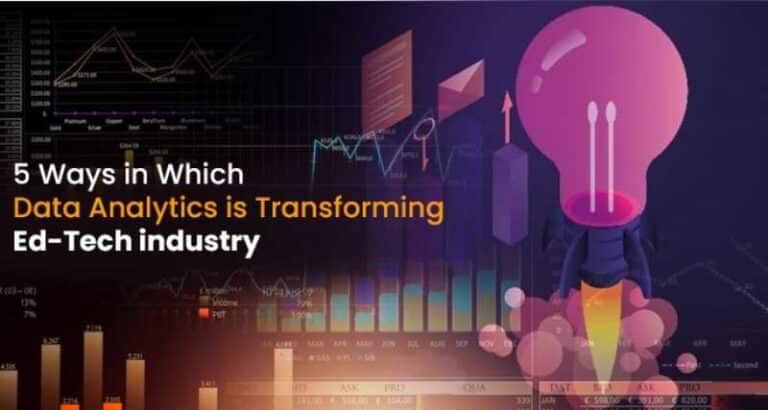The significance of Data Analytics has introduced far-reaching advances to the ed-tech industry under the digitalization trend. It analyzes how using data analytics can have a far reaching impact in the ed-tech sector. . We’ve all seen how old-school methods of acquiring data are being replaced by newer ones based on user feedback.
For example, Data science skills are used in education to organize student data. This information contains demographics, academic records, and performance statistics.
These data analyses, based on technology, free instructors from the burden of traditional information structuring. They zip from one counter to the next, paper in hand.
Big Data science in the education sector
Previously anyone may now complete labor-intensive aspects of schooling with a single click or even automatically. Teachers, for example, no longer have to keep track of students’ attendance or anticipate the number of questions in a test.
They are also responsible for going through every response sheet. Because of advancements in technology, it is fully automated. As a result, teachers may concentrate on their primary mission: teaching.
Interactive and immersive learning is also possible thanks to audio and visual aids. Thanks to artificial intelligence, learners may examine live 3D patterns of anything and study them from many internet resources.
Teachers may use simulations of various learning scenarios to better prepare for class. Improving and sustaining ideas based on students’ previous successes and learning patterns are also helped by machine-learning algorithms—this aids in accomplishing a variety of goals.
Benefits of Big Data science in the education sector
With this in mind, you now understand that dealing with large volumes of data is both valuable and challenging. The more information instructors have on their students’ progress, and the more impactful their action plans will be.
A project of this kind might have a variety of objectives. For example, it can improve student achievement, it can improve their consistency, or they can learn hands-on. The more data instructors have to work with to make matters worse, the harder it is to go through and assess everything.
Teachers can more easily gather data in this location and use it for data analysis. The technique takes care of the rest, leaving them to focus just on transforming the results into actionable steps, or they can take an online Data science course.
Data Analysis is all about gathering the data, storing it and then assessing it for a possible outcome. Students, teachers, courses, and adroitness data are all managed using data analysis in edtech.
These data analyses, based on technology, free instructors from the burden of traditional information structuring. They zip from one counter to the next, paper in hand. Analyze educational technology data to:
1. Prevents errors:
Data analysis ensures that the results are accurate, checking for errors made during the interpretation step. Errors are more likely when data are computed or graphs or tables are manually formed; it is better to take an online Data science course for better understanding. However, traditional data processing still involves people, which is why this is the case.
2. Makes the educational process more dynamic:
Using data analysis to improve your company is a win-win situation. You can pay attention to the outcomes and procedures. As a result, a more proactive approach is required. Keeping an eye out for methods to improve the organization’s performance is possible.
3. Customizes instruction to meet individual student needs:
Being proactive centers on the expansion of your institution’s programs. As a result of data analysis, it is possible to tailor student learning by analyzing student performance. Using this method may be used to personalize schooling.
4. Increasing Student Achievement:
Data analysis may help you improve student performance. Schools now can retain an infinite amount of information on their students in databases as post covid it has become online education. This information contains demographics, academics, and character descriptions of students.
The teacher may make predictive judgments based on this information, which educators can use. For example, a teacher can forecast how pupils will do in the future by studying how they typically perform.
As soon as they see that any student’s academic progress has slowed significantly, they should take action. As a result, teachers use data analysis to increase student involvement in their classroom sessions.
Teachers may accurately divide students into groups using data analysis based on their abilities. In addition, they can mix students of varied talents and backgrounds since they have access to student bios.
5. Updating Your Computer’s Operating System:
As more and more people turn to the internet, it’s safe to assume that they’re paying closer attention to their applications. Students and teachers that use the software in the classroom are immediately more aware of the wide range of internet material available.
For active online education and engagement, updating software is a count-one rule. Educators may use data analysis to gather information and statistics. Data analysis devices may be tailored to meet your organization’s specific needs and objectives.
Conclusion:
Schooling and skill growth should be balanced to a fine degree so far skilling and academics are concerned. Although most traditional examinations focus on measuring knowledge outcomes, skill gaps go unchecked all too often.
Nearly two-thirds of the population in India is under the age of 18, and education has long been seen as a key component in the country’s growth. To get out of this, anyone can take an online Data science course.
